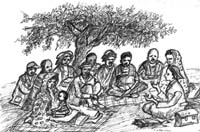2.6 Health Extension Practitioners and health education

The Health Extension Programme is an innovative community-based programme. As a Health Extension Practitioner you will be expected to help address the health problems of your community. All your efforts on health promotion and disease prevention activities should include the full participation and involvement of your community members (Figure 2.7). Health education is an important tool that helps you to implement all community-based packages of the Health Extension Programme.
The Health Extension Programme focuses mainly on prevention and community-based health promotion activities. Preventive activities are usually considered in the levels:
- Primary prevention includes those measures that prevent the onset of illness before the disease process begins. Immunization against infectious disease is a good example.
- Secondary prevention includes those measures that lead to early diagnosis and prompt treatment of a disease. Breast self-examination is a good example of secondary prevention.
- Tertiary prevention involves the rehabilitation of people who have already been affected by a disease, or activities to prevent an established disease from becoming worse. These activities are less likely to be undertaken by Health Extension Practitioners.
At the primary prevention level your health education activities will focus on changing behaviour by raising awareness of the risk factors that predispose your community members to future health problems. For example, imagine that you distribute insecticide treated bed nets (ITN) to prevent the pregnant mothers in your area getting infected with malaria. This is primary prevention because you are preventing exposure to malaria. Your role as Health Extension Practitioner is to use health education to create awareness among the pregnant women on how and why to use ITN. Health education also includes secondary prevention methods such as early diagnosis and treatment and extends to tertiary prevention such as rehabilitation.
Before finishing this session, think about a health education issue that you are familiar within your community or area. Make a note of a primary prevention action and a secondary action that has been taken.
Make sure that you are comfortable with the difference between primary prevention activities and secondary prevention activities. Remember that primary prevention activities will actually stop the illness happening, while secondary activities stop the illnesses getting worse.
2.5 Community development
